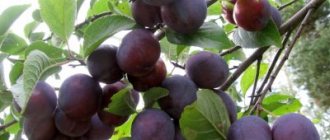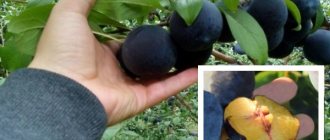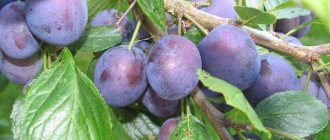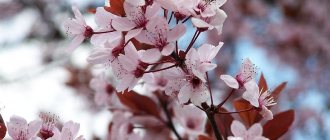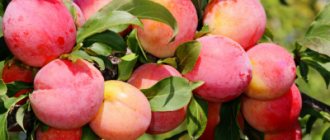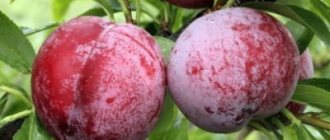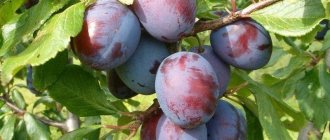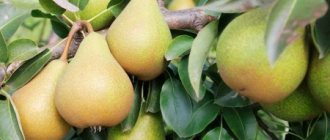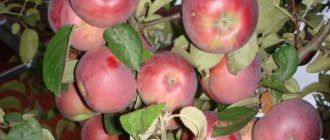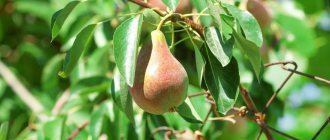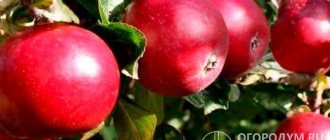What does "columnar" plum mean?
Columnar plum is a tree whose crown grows in the shape of a column. Its branches do not spread out, as usual, but stretch upward and are often hung with a large number of fruits.
At the same time, this type of plum was not created artificially at all. This mutation was discovered completely by accident in the 60s of the last century by a breeder in America.
The scientist saw a branch that was thicker and growing vertically on a Mackintosh apple tree. Its trunk was abundantly strewn with apples. This interested the breeder, and he tried to propagate this specimen, which eventually produced the “Vozhak” variety of columnar apple tree after 2 years. In a similar way, pear and plum trees were also obtained, characterized by good yields and easy cultivation.
Columnar plum varieties for you
The first columnar apple and pear trees appeared in Russian gardens about twenty years ago. Columnar plums with poorly developed or absent skeletal branches are even more rare, but the advantages of this unusual crop are already of interest to both summer residents and owners of farm gardens.
A natural mutation of fruit plants, which led to a form unconventional for trees, was noticed and fixed. As a result, today enthusiasts have several varieties at their disposal with large fruits of universal use.
Advantages and disadvantages of columnar plum
Columnar plum, like any other fruit tree, has its advantages and disadvantages. Let's look at this in more detail.
Advantages of columnar plum tree:
- Good harvest. Depending on the variety, from 6 to 11 kg of fruit can be collected from one tree. This is due to the small number of branches, which is why nutrients go directly to fruiting.
- Precocity. The first harvest can be harvested already 2 years after planting, and by 4-7 years of life the tree will reach its peak yield, which will not change for another 10 years. And only by the 14-17th year of life, the plum tree will gradually stop producing fruit.
- Cold resistance and endurance. Columnar trees tolerate frosts down to -30°C, which makes it possible to expand the geography of planting from Siberia to the Krasnodar Territory. And the branches of such a plum are strong and calmly support the weight of ripened fruits.
- Crown shape. Since the tree has only one trunk, and there are very few “extra” branches, there is no need to do frequent pruning.
As for the disadvantages, gardeners note the relatively short period of fruiting of the tree. By the age of ten, the aging mechanism of plums begins to turn on, and the yield gradually decreases. Therefore, if you are interested in a bountiful harvest, the trees need to be renewed. This can be done 13 or 15 years after planting, replacing old trees with new seedlings. However, trees that have stopped producing fruit can not be uprooted, but left as a decorative decoration for the garden.
Characteristics of the species
Columnar plants are characterized as small trees with an undeveloped crown and a small number of tiny branches. The appearance of the crown vaguely resembles narrow Egyptian pyramids. This tree bears fruit with fairly large fruits. Externally, the plant looks inconspicuous and fragile, but the wood is durable and can withstand harvests of up to 10 kg.
Important! Despite their good hardiness, plants need to be tied up to reduce the risk of trunk fracture.
This species is distinguished by early fruiting. Trees begin to bear fruit a couple of years after planting. There are two types: self-fertile and requiring a third-party pollinator.
During the first few years, the yield only increases. In general, varieties of this type of garden crop can bear fruit for 16 years, and even after this time they will become an excellent designer decoration for a personal plot.
Columnar plum
Pollination and "neighborhood"
Some varieties of columnar plums have the ability to self-pollinate (for example, Imperial, Commander, Rubin, Angers). But for the most part, such trees need pollinators to produce crops.
Pollination mainly occurs with the help of bees. But during cold spells, frosts or prolonged rains, their activity decreases, so experienced gardeners plant pollinating varieties nearby. And trees that have the ability to self-pollinate make it possible to harvest even in unfavorable weather. Entire gardens can be formed from such varieties, but the harvest may not be as desired.
As for the “neighborhood”, the following will calmly get along next to a plum tree:
- plum trees;
- apple trees;
- quince and cherry plum.
From the bushes nearby you can plant raspberries, black currants, and gooseberries. Since the crown of a columnar tree provides little shade, lilies of the valley, hyacinths, primrose or other primroses can be planted under the tree. Thyme does not interfere with the development of the tree.
It must be remembered that plums do not tolerate pears, nuts, peaches, cherries, sweet cherries and sea buckthorn as a “neighbor”. She also will not like the proximity of birch, fir or poplar.
Columnar plum variety Blue Sweet
The columnar plum variety Blue Sweet is suitable for private gardens from the Moscow region to the southern regions. Trees up to 2.5 meters high are distinguished by a small trunk, extremely rare formation of lateral branches and abundant fruiting. On fruit trees, with proper agricultural technology, up to 15 kilograms of large dark blue fruits ripen. If the summer is warm enough, the fruits, which are not prone to cracking, gain weight up to 60–70 grams. Under the skin covered with a bluish waxy coating lies juicy, bright yellow flesh with a sweet and sour taste.
A pleasant bonus for lovers of fresh fruits of the Blue Sweet variety will be the oval-pointed stone, which can be easily separated from the melting pulp.
Plums are ready for harvesting in the 3rd–4th week of August or early September. The columnar plum variety is winter-hardy and can withstand the cold of the middle zone without additional shelter. To obtain a massive harvest, the plant requires pollinators, for example, Stanley trees planted nearby.
What are the columnar varieties?
Varieties of columnar plum trees can have different ripening periods, differ in fruit color and ability to self-pollinate. Among the variety of species, the most common and popular varieties can be identified.
Imperial
Imperial is one of the most popular varieties. It is loved for its large fruits (weighing up to 55 g) and delicate, aromatic taste. The shape of plums is round, with a compressed top and a wide base. The skin of the fruit is quite dense, but this does not in any way affect its taste.
Such a tree grows up to 2 m, and begins to bear fruit by mid-to-late August. It does not need pollinators, as it is a self-pollinating variety. The color of Imperial plums is often pink-violet, but there are also fruits with a red-brown color.
The disadvantages of Imperial include the need for abundant watering and the likelihood of flowering in the first year. If this happens, the inflorescences need to be cut off, since such an early harvest can deplete the young tree.
Blue Sweet
The second most popular type of columnar plum. The fruits of this variety are also large and can reach a weight of 75 g. The shape is oval, slightly flattened. On thick skin there is a waxy coating. Blue Sweet grows to a height not exceeding 2 m. The taste is refreshing with sweet and sour notes.
During the season, about 12-15 kg of plums are collected from the tree. The fruits ripen towards the end of August and require pollination. This usually happens with Blue Free or Stanley varieties. The color of the fruits of the Blue Sweet variety is purple. And the pulp of plums is pink.
Among the disadvantages of the variety, we can highlight the possible bifurcation of the top of the tree due to frost, which can subsequently cause problems when restoring the shape of the crown. And just like Imperial, this variety can begin to bloom in the first year. If this happens, you need to cut off all the inflorescences that appear.
Yellow
The “Yellow” variety of columnar plum tree is famous for its early fruiting and ability to self-pollinate. The fruits can already be collected at the end of June. The height of the plum is 2.5 m, and the weight of the fruits is from 40 to 70 g each. The plums themselves are round and golden in color. The taste is sweet honey.
Honey
The columnar-shaped plum variety Honey produces yellow-golden, sweet-tasting fruits that weigh up to 50 g. For pollination, it requires the varieties Renklod Karbysheva or Vengerka Donetskaya. Begins to bear fruit from the end of July.
Mirabella
Mirabella is a variety of columnar plums that resembles apricots in appearance. One such fruit weighs about 40 g, and up to 15 kg of plums can be harvested from one crop.
The tree begins to bear fruit in mid-August. Pollinators are not needed. As a plus, one can highlight the tree’s ability to hold fruits on the branches for a long time without shedding.
The tree itself is very small - about 1.7 m. The taste is sweet and sour, the color is yellow, maybe with a slight “blush” on the sides. The downside of this variety is poor separation of the stone from the pulp.
Russian
Another type of columnar plum, which can be considered dwarf, since the growth of such trees does not exceed 1.7 m. The fruits grow small (up to 40 g) and ripen closer to mid-August. Pollination occurs with the help of cherry plum. The plums themselves are red-violet and have a sweet taste.
Ruby
Ruby is a self-pollinating plum variety. The weight of one fruit is about 60 g. The height of the plant is 2 m, the color of the fruit is red, the taste is sweet with a hint of sourness. The disadvantage of this variety is that the fruits are harvested in early September.
Commander
Another self-pollinating variety with oval purple fruits, weighing about 50-55 g. It begins to ripen by mid-summer. Height - up to 2 m. The fruits themselves are very juicy and sweet, with a slight sourness.
Oscar Plus
Oscar Plus is a variety whose fruits appear no earlier than September. The fruits themselves weigh 45-55 g each, have a spherical shape, and their color can vary from pink-violet to brown-red. Pollination of such plums is possible with the help of trees with the same flowering periods. The height of the tree is about 2 meters. The taste is sweet with sourness.
Angers
Angers is a self-fertile mid-season variety. The burgundy fruits of this tree with a purple tint weigh up to 40 g and have a sweetish and sour taste.
Olenka
Bright red plums with a slight purple tint. The fruits of this variety are small - their weight is only 25 g. For pollination and harvesting, it requires trees of the Stanley or Blue Free varieties.
Columnar plum “Imperial”: photo and description of the variety
Columnar plum "Imperial" has a height of up to two meters and a narrow pyramidal crown. The color of the fruit is pink-violet; in some plums it can become dark burgundy. The pulp is dense, bright yellow. The taste is sweet with barely noticeable sourness. A characteristic feature of the variety is a very pleasant fruity aroma. The weight of one fruit is 40-60 g, oval in shape. Once harvested, the harvest can be stored for up to weeks. Plums ripen from mid-August. The variety is self-sterile and requires pollinators.
Columnar plum "Imperial".
Summary table of varieties by characteristics
To figure out which varieties are best for you, you can study the comparative table with the characteristics of trees.
Table 1 - Characteristics of columnar plum varieties
| Variety name | Growing region | Ripening time | Color |
| Imperial | Moscow region and center of Russia, Northwestern region (St. Petersburg region) | mid to late August | purple, red-brown |
| Blue Sweet | Moscow region and center of Russia, Ural | end of August | dark purple |
| Yellow | Moscow region and center of Russia | end of June | golden |
| Honey | Moscow region and center of Russia, Siberia | end of July | yellow-golden |
| Mirabella | Moscow region and center of Russia | mid-August | yellow, from the side of the sun there may be a slight “blush” |
| Russian | Northwestern region (St. Petersburg region), Ural, Siberia | mid-August | red-violet, dark red |
| Ruby | Siberia | beginning of September | red |
| Angers | Ural | mid-August | burgundy purple |
Characteristics of the variety
It is especially worth paying attention to the top of the tree. It can freeze slightly, resulting in poor yield. To restore fruiting, you need to cut off the blossoms in the first years of the tree’s life. If the Blue Sweet plum blossoms in the first year of its life, you must also remove the flowers so that the tree produces a large harvest.
Drought resistance, frost resistance
Columnar variety Blue Sweet is resistant to frost and drought. However, during periods of frost, you need to carefully monitor the top of the plum. In the summer heat, it is necessary to water the plum tree more often. Then she will be tall - up to 2.2 m in height. It will also be interesting to watch a video about care:
Pollinators of columnar plum Blue Sweet
This plum variety cannot pollinate on its own. Therefore, we need pollen from varieties of non-columnar plums or similar ones - Stanley, Blue Free. And pollinating bees are needed as carriers, so it’s worth taking care of the apiary if insects are not found nearby.
Productivity and fruiting
The Blue Sweet plum variety blooms in the first year, but it is better to wait until the second year for a better harvest. The first fruits can be seen in August. One young plum initially produces 15-16 kg of harvest, which is not much at all. An adult pyramidal tree of a columnar variety produces three times more yield. It takes up little space, so it is convenient to plant several plums next to each other.
Area of application of berries
Growing the Blue Sweet columnar plum is possible at home for personal consumption, as well as in industry - for processing and subsequent preservation for export.
Resistance to diseases and pests
The columnar plum variety Blue Sweet practically does not get sick. Rodents and fungal infections are not scary for him. This is a big advantage, because it does not require maintenance.
Advantages and disadvantages of the variety
This variety of columnar plum always bears a lot of fruit, the harvest is rich and good. The quality properties do not change during the entire fruiting period.
From the first year it can bear fruit, blooms quickly, and takes root well in new places. During transportation, it does not change its presentation and does not deteriorate as quickly as other varieties of columnar fruits.
Landing Features
The abundance of the harvest and the health of columnar trees depend on compliance with the technology of planting and growing these crops.
Planting columnar plums begins with selecting seedlings. After that, a place for the trees is selected and the soil is prepared accordingly.
Selection of seedlings
Purchasing a particular variety of columnar plum depends on your personal preference. Focus on the seedlings’ resistance to the region’s weather conditions, diseases, and ability to produce the amount of harvest you need.
When choosing a columnar plum seedling, look at its roots - they should be without damage, dry or broken shoots, and have many branches. The branches should also be in good condition, without signs of disease.
What else can you recommend when buying columnar plum seedlings:
- choose an annual crop, since an older seedling may find it more difficult to take root in a new place;
- purchase seedlings from specialized nurseries - this way you are more likely to get a tree already adapted to the climatic conditions of your region.
When choosing a seedling in a nursery, also ask for advice from a specialist in the care and cultivation of the purchased variety.
Choosing a place and time
The main thing when growing columnar plums is not to miss the time of planting the seedlings. Frosts and unfavorable weather conditions can damage the top of the tree, which will negatively affect its development and crown formation.
Deciding when to plant trees should be based on the climatic characteristics of the region. For example, for southern Russia the best planting time is autumn, and in northern latitudes, in the Urals and in the middle zone - spring (after the snow has melted and the cold weather has finally gone away).
As for the landing site, it should be:
- sunny - columnar plum does not like shade;
- protected from wind and drafts;
- having non-swampy, light soil (for example, sandy loam);
- with a groundwater level of at least 1.5 m.
Do not plant plums in lowlands, as they are cooler there than at higher elevations and groundwater often accumulates. If these conditions are not maintained, then the roots of the seedlings may rot, the trunk is damaged and the plum tree begins to hurt.
Soil preparation
Before you start planting a crop, you should prepare the soil:
- treat the selected area with humus (usually 3-4 kg per tree), then loosen the soil and level it;
- Dig a hole for the seedling in advance (30-40 cm wide and 2 times the depth of the tree’s root system), then place a mixture of soil and fertilizer at the bottom of the hole;
- as a fertilizer, use up to 80 g of potassium and up to 100 g of superphosphate - add nutrients to the bottom on the day of soil preparation, so that by the time the tree is planted, the mixture has already settled.
Landing technology
To avoid mistakes when landing, follow these step-by-step recommendations:
- Plant columnar plums at a distance of 50 cm from each other. And maintain a width between rows of about 1-1.5 m.
- Place a fertile substance (for example, humus mixed with soil) at the bottom of the dug holes. Take 3-4 kg of substrate for one seedling. Mineral or other additives cannot be used during planting, since the weak roots of the seedling can be easily damaged by chemical exposure.
- Next, place the tree in the prepared hole, and carefully straighten its roots. In this case, the root collar (the place where the color of the trunk changes from greenish to brown) should protrude 3-4 cm above the ground.
- If there is groundwater near the planting site, arrange drainage at the bottom of small stones or broken bricks.
- After placing the crop in the hole, fill the hole with clean soil and then compact it around the trunk. Then water the tree. To ensure that the seedling grows evenly, tie it to a support.
Additionally, after planting, use stimulants for better root growth. For example, Kornevin. It is quite simple to prepare: dilute 5 g of the drug in 5 liters of water. The norm for one seedling is 350 ml. You can apply the substance a second time 3 weeks after planting. The main thing is to maintain all proportions - an overdose of stimulants is unacceptable!
The process of planting a columnar plum is presented in this video:
How does a columnar plum grow?
And now I will describe my direct observation of the columnar plum. At the time of planting, the columnar plum seedlings were long thin twigs, which were not much different from the seedlings of standard fruit trees of this age, so it was too early to draw conclusions. But after about 3 years, it was already clear that the trees were clearly unusual - they did not form and, it seems, did not plan to form the type of crown characteristic of ordinary tree species.
The trees grew predominantly upward; they had lateral skeletal branches, but they departed from the trunk only at an acute angle. Of course, the trees were originally planted quite close to each other, and this, to a certain extent, affects how narrow or spreading the crown will be. But nevertheless, it was clearly visible that the narrow crown was genetically determined in these crops.
Already in the year of planting, all the seedlings bloomed, but either they did not produce a harvest, or the ovaries fell off and only a couple of fruits ripened. The columnar plum was able to produce its first good harvest (almost like an ordinary one) only in the third year. At the moment of its fruiting, I was just able to observe the tree and I can say with full responsibility that, of course, a columnar plum with a live harvest does not look like it is depicted on advertising sites, where a photo montage is visible to the naked eye. That is, these are not the only trunk densely covered with fruits from the very ground to the top.
In reality, a columnar plum at the age of five is a two-meter tree with a thin trunk and thin branches of the first order directed upward, the crown volume is less than one meter. The fruits of the columnar plum appear both on the trunk itself and on the skeletal branches, mainly in the upper part of the crown. That is, strictly speaking, such plums still have a narrow pyramidal rather than columnar shape.
In general, probably, eminent gardeners who claimed that there really are no such plums are partly right. It would be more correct to call this crop not a columnar plum, but a “dwarf pyramidal” plum. “Columnar” is more, in fact, a “trademark”, an advertising ploy. But is this really so important for ordinary gardeners?
What do we expect from columnar trees? So that they are compact, low, do not take up much space, do not overly shade the area, but at the same time bring a good harvest. And columnar plums fulfill all these expectations, although their crown is perhaps more like a panicle than a column (although some consider them just a wide column).
Structure of a columnar plum. © Lyudmila Svetlitskaya
How to care for a planted tree?
After the tree has been planted in the ground, all that remains is to properly care for it in order to get a bountiful harvest.
Irrigation scheme
Columnar plum trees like moderately moist soil and respond well to watering. This should be done once a month (spring, summer and autumn), watering the seedling abundantly with water. If the weather is extremely dry in the summer, then more often, depending on the needs of the tree.
How, when and what to feed?
In order for a plum to grow well and delight with good tasty fruits, it must be fed. One of the most popular fertilizers is urea: 50 g of the substance is diluted in 10 liters of water. One plum requires 2 liters of solution.
The feeding scheme is as follows:
- 1 time - after the release of the buds;
- 2 times – 14 days after the first feeding;
- 3 times – 14 days after the second refill.
In the second year of growth of a columnar plum, you can feed it with saltpeter, diluting 20 g per 1 liter, and also use growth stimulants.
During the first 2-3 years of the tree’s life, the fertilizers that were added during planting are sufficient. And then feeding begins three times a year:
- in spring - nitrogen substances;
- in summer - potassium;
- in autumn - with phosphorus.
Do I need to prune columnar plum trees?
Columnar trees require little to no pruning as they have very few sideways growing branches. Trim only diseased or damaged branches.
Pruning will also be necessary if the top has frozen a little, as a result of which several shoots have grown from it. In this case, choose the strongest trunk and trim the rest so that they do not interfere with the normal development of the crown.
Mulching
To ensure that oxygen reaches the roots of the crop in sufficient quantities, periodically loosen the soil around the trunk and also remove all weeds. The tree will also benefit from mulching the tree trunk circle with humus or peat. More information about soil mulching can be found here.
Preparing for winter
During the first two years of life, the columnar plum is very susceptible to low temperatures, so it requires some preparation to enter the winter period.
Preparing a tree for winter includes the following steps:
- last autumn watering;
- fertilizing with phosphorus or organic matter under the trunk;
- covering the tree trunk circle with spruce branches, straw or hay.
If the winter is snowy, use additional snow, compacting it tightly around the tree.
Diseases, pests, treatment and prevention
Columnar-shaped plum trees are quite resistant to disease, but if the roots of the crop or its branches are damaged, the plant may get sick. In this case, the main thing is to recognize the disease in time and begin its treatment.
Diseases, their symptoms, causes and methods of treatment:
| Disease | Symptoms | Causes | Treatment |
| Coccomycosis | red spots on leaves that begin to fall off | excess moisture | spray with copper chloride or Bordeaux mixture |
| Gommoz | resin drops on a tree trunk and branches | severe frost, overdose of fertilizers, excess moisture | treat with 1% solution of copper sulfate |
| Clusterosporiasis | brown spots, “burning” leaves | fungi | apply "Topsin-M" according to the instructions |
As for prevention, try to remove all weeds around the tree in a timely manner and fertilize the crop.
When and how to harvest?
The time for harvesting plums depends on its variety and climate. For example, in Siberia and the Urals, plums ripen in late summer - early autumn, while in the southern regions of Russia you can harvest some varieties by the end of June.
Early varieties of fruits are harvested over several weeks, and late varieties are harvested all at once, since they ripen almost simultaneously. In order not to be mistaken about the degree of ripeness of a plum, taste it, since the acquisition of the final color does not mean that the fruit is ready for picking.
Rules for harvesting plums:
- collect fruits only in dry weather;
- if the variety is early ripening, remove it from the branches in several passes, as the fruits ripen unevenly;
- Pluck plums intended for transportation or storage together with the stalks or carefully cut them, and then immediately place the fruit in trays;
- first remove the fruits from the lower branches, and then from the upper ones;
- start collecting from the ends of the branches, approaching the trunk;
- During work, do not crush the plums and do not damage the wax coating and the stalk.
Features of storage and transportation
To prevent fruits from spoiling during storage, observe the following conditions:
- maintain the temperature in the storage area around 0-2°C, and the humidity at least 85%;
- store fruits in low trays with paper at the bottom or in wooden boxes;
- When transporting, try not to damage the wax coating.
It is better to eat plums that for some reason you will not store immediately or process them for winter preparations.
Do not store unripe picked plums in the refrigerator - this will stop the ripening process of the fruit and kill its taste. Place the plums in a bowl and leave it on the counter at room temperature. Do not place plums on the windowsill - the sun will overheat the fruit and it will begin to rot.
Remove plums that will be transported from the branches five days before they become completely ripe. They can be stored for three weeks at around 7°C.
Reviews from gardeners
★★★★★
Sergey, 37 years old, Orel, entrepreneur. I decided to plant columnar plums in my dacha.
I chose Imperial and Mirabella. And for three years now I have been collecting a wonderful harvest from them. Everyone is happy. ★★★★★
Julia, 45 years old, Kemerovo, teacher. I planted a columnar plum variety Rubin.
The fruits turned out very tasty. Plum is easy to care for and yields a lot of fruit. Hide
Add your review
See also the video review, where one of the gardeners tells his impressions of growing a columnar plum:
Columnar plum is excellent for growing in almost any region of Russia. Its main advantages - resistance to frost, abundant fruiting and ease of care ensure this tree is in considerable demand throughout the country.
1
0
Copy link

